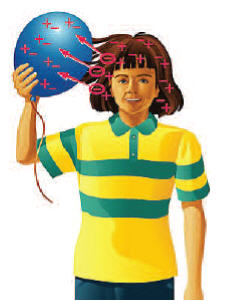Charge It! Activity
Background
| Static electricity is the buildup of electric charge on an object.
That charge may be positive or negative, depending on
whether the object loses or gains electrons. It may result
from the transfer of electrons from one object to another or
from one location to another within the same object. One way electrons get transferred is through friction. For example, when you rub a balloon against your head, electrons in the atoms that make up your hair rub off onto the balloon. This loss of electrons leaves your hair with an overall positive charge. The gain of electrons leaves the balloon with an overall negative charge. Charged objects interact in very specific ways. In this activity, you are going to build up electric charges on balloons and investigate the forces that they exert on other objects. |
 |
Materials
- 2 balloons
- scrap of paper
Steps
1. Blow up a balloon and tie it off. Rub the balloon against your clean, dry hair for several seconds.
Then hold the balloon near but not touching your head. What happens to your hair?
______________________________________________________________________________________
______________________________________________________________________________________
2. The balloon is negatively charged, and your hair is positively charged. What can you conclude
about unlike charges?
______________________________________________________________________________________
______________________________________________________________________________________
3. Blow up a second balloon and tie it off. Rub both balloons against your hair. Place one balloon on
the table. Slowly move the other balloon near it. What happens? What charge do the balloons have?
______________________________________________________________________________________
______________________________________________________________________________________
4. Are there any strands of hair clinging to the balloons? Pull off two and hold the strands close together.
What happens? What charge do the strands of hair have?
______________________________________________________________________________________
______________________________________________________________________________________
5. What can you conclude about like charges?
______________________________________________________________________________________
______________________________________________________________________________________
6. Finally, tear up some paper into tiny bits and sprinkle them on the table. Rub one balloon against
your hair. Place the balloon near (but not touching) the bits of paper. What happens?
______________________________________________________________________________________
______________________________________________________________________________________
7. The balloon is negatively charged, but the bits of paper are neutral (have no charge). What must
have happened to the electrons in the atoms that make up each bit of paper?
______________________________________________________________________________________
______________________________________________________________________________________
